Rapid Detection of Porcine DNA in Meatball Using Recombinase Polymerase Amplification Couple with Lateral Flow Immunoassay for Halal Authentication
Abstract
1. Introduction
| Method | Target | Gene | Amplification Condition | Detection | Sensitivity | References |
|---|---|---|---|---|---|---|
| PCR | Pig, Monkey, Dog, Rat, Cat | ND5 ATPase Cytb | 60–94 °C; 1 h | Electrophoresis | 0.01–0.02 ng/µL | [15] |
| Real-time PCR | Dog | Cyt b | 1 h | Fluorescence | 0.5 pg/µL | [16] |
| Real-time PCR | Pig | d-loop | 53–95 °C; 1 h | Fluorescence | 5 pg/µL | [11] |
| Real-time PCR | Pig | Cytb d-loop | 64–98 °C; 20 min | Fluorescence | 0.01% binary meat mixture | [13] |
| Isothermal (LAMP) | Pig | d-loop | 65 °C; 1 h | SYBR Green I | 0.5 ng/µL | [17] |
| PCR | Cow, Buffalo, Chicken, Duck, Sheep, Goat, Pig | Cytb ND5 | 60–95 °C; 1 h | Electrophoresis | 0.01–0.005 ng/µL | [18] |
| PCR | Dog, Pig, Monkey, Cat, Rat | ATPase ND5 Cytb | 58–95 °C; 1.5 h | LFD | 0.01–1 ppm | [19] |
| Isothermal (RPA) | Pig | Cytb | 39 °C; 20 min | LFD | 0.01 ng/µL | This work |
2. Results and Discussion
2.1. Specificity of RPA Assays
2.2. Sensitivity (Detection Limit)
2.3. Application of RPA NALFIA in Meatball Samples
3. Materials and Methods
3.1. Samples Collection and DNA Extraction
3.2. Design of Oligonucleotide Primers
3.3. RPA Assay for DNA Amplification
3.4. Gel Electrophoresis
3.5. Nucleic Acid Lateral Flow Immunoassay (NALFIA) Detection
3.6. Specificity and Sensitivity of the RPA Assays
4. Conclusions
Author Contributions
Funding
Institutional Review Board Statement
Informed Consent Statement
Data Availability Statement
Acknowledgments
Conflicts of Interest
References
- Ballin, N.Z. Authentication of meat and meat products. Meat Sci. 2010, 86, 577–587. [Google Scholar] [CrossRef] [PubMed]
- Di Pinto, A.; Bottaro, M.; Bonerba, E.; Bozzo, G.; Ceci, E.; Marchetti, P.; Mottola, A.; Tantillo, G. Occurrence of mislabeling in meat products using DNA-based assay. J. Food Sci. Technol. 2015, 52, 2479–2484. [Google Scholar] [CrossRef] [PubMed]
- Kumar, Y.; Karne, S.C. Spectral analysis: A rapid tool for species detection in meat products. Trends Food Sci. Technol. 2017, 62, 59–67. [Google Scholar] [CrossRef]
- Tafvizi, F.; Hashemzadegan, M. Species identification of chicken and soybean fraud in premium burgers using multiplex-PCR method. J. Food Sci. Technol. 2016, 53, 816–823. [Google Scholar] [CrossRef][Green Version]
- Ghovvati, S.; Nassiri, M.R.; Mirhoseini, S.Z.; Moussavi, A.H.; Javadmanesh, A. Fraud identification in industrial meat products by multiplex PCR assay. Food Control 2009, 8, 696–699. [Google Scholar] [CrossRef]
- Fuseini, A.; Wotton, S.B.; Knowles, T.G.; Hadley, P.J. Halal meat fraud and safety issues in the UK: A review in the context of the European Union. Food Ethics 2017, 1, 127–142. [Google Scholar] [CrossRef]
- Sajali, N.; Chuong, W.S.; Abu, B.S.; Mokhtar, N.F.K.; Manaf, Y.N.; Yuswan, M.H.; Desa, M.N.M. Analytical approaches of meat authentication in food. Int. J. Food Sci. Technol. 2020, 56, 1535–1543. [Google Scholar] [CrossRef]
- Erwanto, Y.; Abidin, M.Z.; Muslim, E.Y.P.; Sugiyono, S.; Rohman, A. Identification of pork contamination in meatballs of Indonesia local market using polymerase chain reaction-restriction fragment length polymorphism (PCR-RFLP) analysis. Asian Aust. J. Anim. Sci. 2014, 27, 1487–1492. [Google Scholar] [CrossRef]
- Ahda, M.; Guntarti, A.; Kusbandari, A. Application of high pressure liquid chromatography for analysis of lard in the meatball product combined with principal component analysis. Asian J. Pharm. Clin. Res. 2016, 9, 120–123. [Google Scholar] [CrossRef]
- Majchrzak, K.K.; Czarna, N.K.; Sumara, A.; Fornal, E.; Montowska, M. Multispecies identification of oilseed and meat specific proteins and heat-stable peptide markers in food products. Molecules 2021, 26, 1577. [Google Scholar] [CrossRef]
- Orbayinah, S.; Hermawan, A.; Sismindari; Rohman, A. Detection of pork in meatballs using probe taqman real-time polymerase chain reaction. Food Res. 2020, 4, 1563–1568. [Google Scholar] [CrossRef]
- Mortas, M.; Awad, N.; Ayvaz, H. Adulteration detection technologies used for halal/kosher food products: An overview. Discov. Food 2022, 2, 15. [Google Scholar] [CrossRef]
- Wu, H.; Qian, C.; Wang, R.; Wu, C.; Wang, Z.; Wang, L.; Zhang, M.; Ye, Z.; Zhang, F.; He, J.; et al. Identification of pork in raw meat or cooked meatballs within 20 min using rapid PCR coupled with visual detection. Food Control 2020, 109, 106905. [Google Scholar] [CrossRef]
- Hrbek, V.; Zdenkova, K.; Jilkova, D.; Cermakova, E.; Jiru, M.; Demnerova, K.; Pulkrabova, J.; Hajslova, J. Authentication of meat and meat products using triacylglycerols profiling and by DNA analysis. Foods 2020, 9, 1269. [Google Scholar] [CrossRef]
- Ali, M.E.; Razzak, M.A.; Abd Hamid, S.B.; Rahman, M.M.; Al Amin, M.; Abd Rashid, N.R. Multiplex PCR assay for the detection of five meat species forbidden in Islamic foods. Food Chem. 2015, 177, 214–224. [Google Scholar] [CrossRef]
- Rohman, A.; Pebriyanti, N.W.; Sismindari; Windarsih, A.; Ramadhani, D.; Rien Larasati, R.; Yulisa, H. Real-time polymerase chain reaction for identification of dog meat in adulterated beef meatball using specific primer targeting on cytochrome-b for halal authentication. Int. J. Food Prop. 2020, 23, 2231–2241. [Google Scholar] [CrossRef]
- Girish, P.S.; Barbuddhe, S.B.; Kumari, A.; Rawool, D.B.; Karabasanavar, N.S.; Muthukumar, M.; Vaithiyanathan, S. Rapid detection of pork using alkaline lysis-loop mediated isothermal amplification (AL-LAMP) technique. Food Control 2020, 110, 107015. [Google Scholar] [CrossRef]
- Uddin, S.M.K.; Hossain, M.A.M.; Chowdhury, Z.Z.; Johan, M.R.B. Short targeting multiplex PCR assay to detect and discriminate beef, buffalo, chicken, duck, goat, sheep and pork DNA in food products. Food Addit. Contam. Part A 2021, 38, 1273–1288. [Google Scholar] [CrossRef]
- Denyinghot, A.; Srinulgray, T.; Mahamad, P.; Ruangprach, A.; Sa-I, S.; Saerae, T.; Vesaratchavest, M.; Dahlan, W.; Keeratipibul, S. Modern on-site tool for monitoring contamination of halal meat with products from five non-halal animals using multiplex polymerase chain reaction coupled with DNA strip. Food Control 2022, 132, 108540. [Google Scholar] [CrossRef]
- Ali, M.E.; Hashim, U.; Mustafa, S.; Man, Y.B.C. Swine-specific PCR-RFLP assay targeting mitochondrial cytochrome B gene for semiquantitative detection of pork in commercial meat products. Food Anal. Methods 2012, 5, 613–623. [Google Scholar] [CrossRef]
- Sahilah, A.M.; Liyana, M.N.L.; Aravindran, S.; Aminah, A.; Khan, A.M. Halal authentication in Malaysia context: Potential adulteration of non- Halal ingredients in meatballs and surimi products. Int. Food Res. J. 2016, 23, 1832–1838. [Google Scholar]
- Arini, R.L.; Ramadhani, D.; Pebriyanti, N.W.; Sismindari; Rohman, A. The use of species-specific primer targeting on D-loop mitochondrial for identification of wild boar meat in meatball formulation. J. Adv. Vet. Anim. Res. 2018, 5, 361–368. [Google Scholar] [CrossRef]
- Yusop, M.H.M.; Bakar, M.F.A. Review on halal forensic: A focus on DNA-based methods for pork authentication. Food Res. 2020, 4, 2347–2354. [Google Scholar] [CrossRef]
- Li, J.; Pollak, N.M.; Macdonald, J. Multiplex detection of nucleic acids using recombinase polymerase amplification and a molecular colorimetric 7-Segment display. ACS Omega 2019, 4, 11388–11396. [Google Scholar] [CrossRef] [PubMed]
- Fu, M.; Zhang, Q.; Zhou, X.; Liu, B. Recombinase polymerase amplification based multiplex lateral flow dipstick for fast identification of duck ingredient in adulterated beef. Animals 2020, 20, 1765. [Google Scholar] [CrossRef]
- Kissenkötter, J.; Böhlken-Fascher, S.; Forrest, M.S.; Piepenburg, O.; Czerny, C.P.; El Wahed, A.A. Recombinase polymerase amplification assays for the identification of pork and horsemeat. Food Chem. 2020, 322, 126759. [Google Scholar] [CrossRef]
- Lin, L.; Zheng, Y.; Huang, H.; Zhuang, F.; Chen, H.; Zha, G.; Yang, P.; Wang, Z.; Kong, M.; Wei, H.; et al. A visual method to detect meat adulteration by recombinase polymerase amplification combined with lateral flow dipstick. Food Chem. 2021, 354, 129526. [Google Scholar] [CrossRef]
- Cao, Y.; Zheng, K.; Jiang, J.; Wu, J.; Shi, F.; Song, X.; Jiang, Y. A novel method to detect meat adulteration by recombinase polymerase amplification and SYBR green I. Food Chem. 2018, 266, 73–78. [Google Scholar] [CrossRef]
- Liu, H.; Cao, R.; Xu, W.; Ma, Y.; Li, W.; Zhang, Y.; Liu, H. A cost-effective method for the rapid detection of chicken adulteration in meat using recombinase polymerase amplification combined with nucleic acid hybridization lateral flow strip. J. Food Compos. Anal. 2022, 111, 104602. [Google Scholar] [CrossRef]
- Lobato, I.M.; O’Sullivan, C.K. Recombinase polymerase amplification: Basics, applications and recent advances. Trends Analyt. Chem. 2018, 98, 19–35. [Google Scholar] [CrossRef]
- Martzy, R.; Kolm, C.; Krska, R.; Mach, R.L.; Farnleitner, A.H.; Reischer, G.H. Challenge and perspectives in the application of isothermal DNA amplification methods for food and water analysis. Anal. Bioanal. Chem. 2019, 411, 1695–1702. [Google Scholar] [CrossRef] [PubMed]
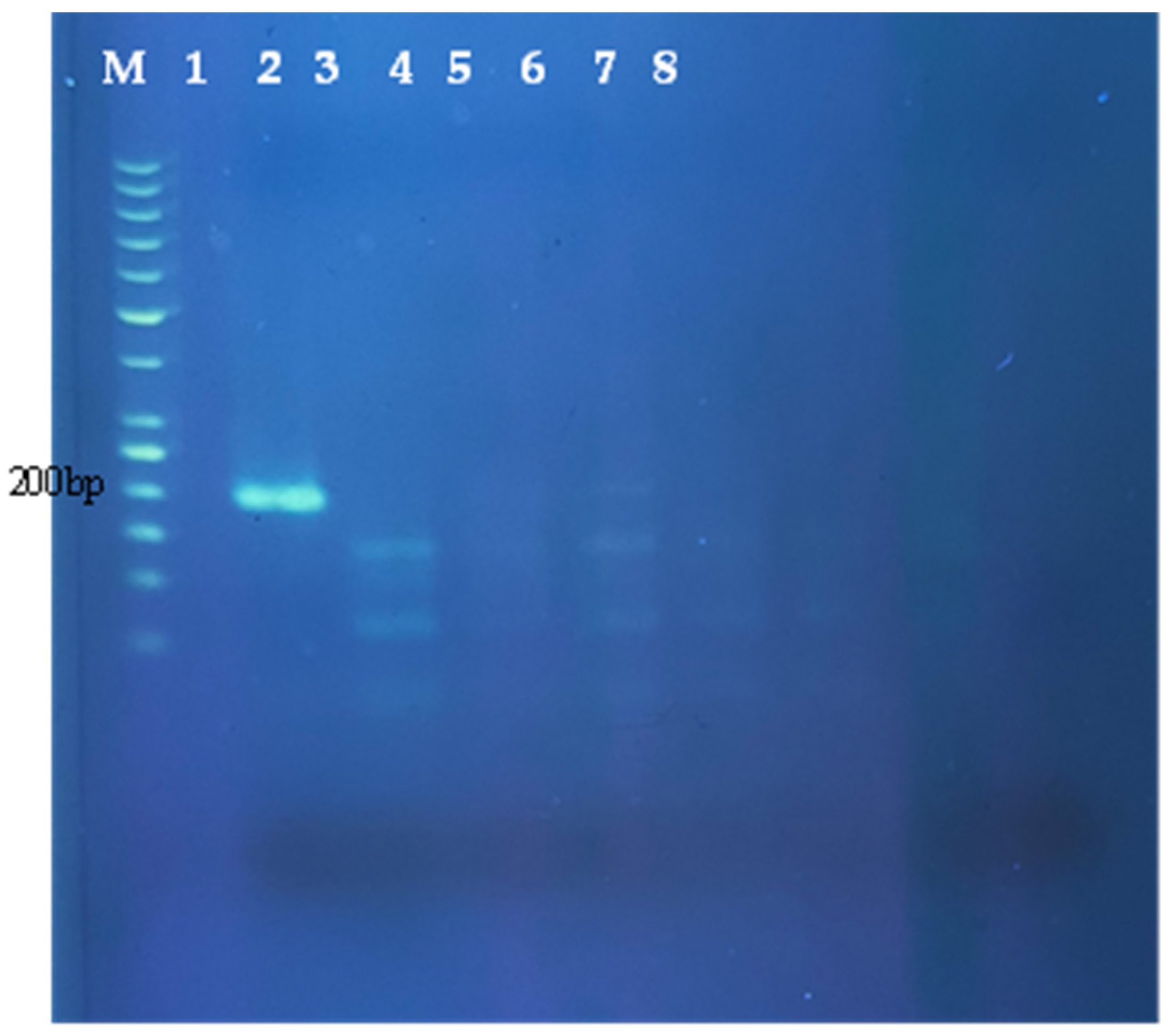
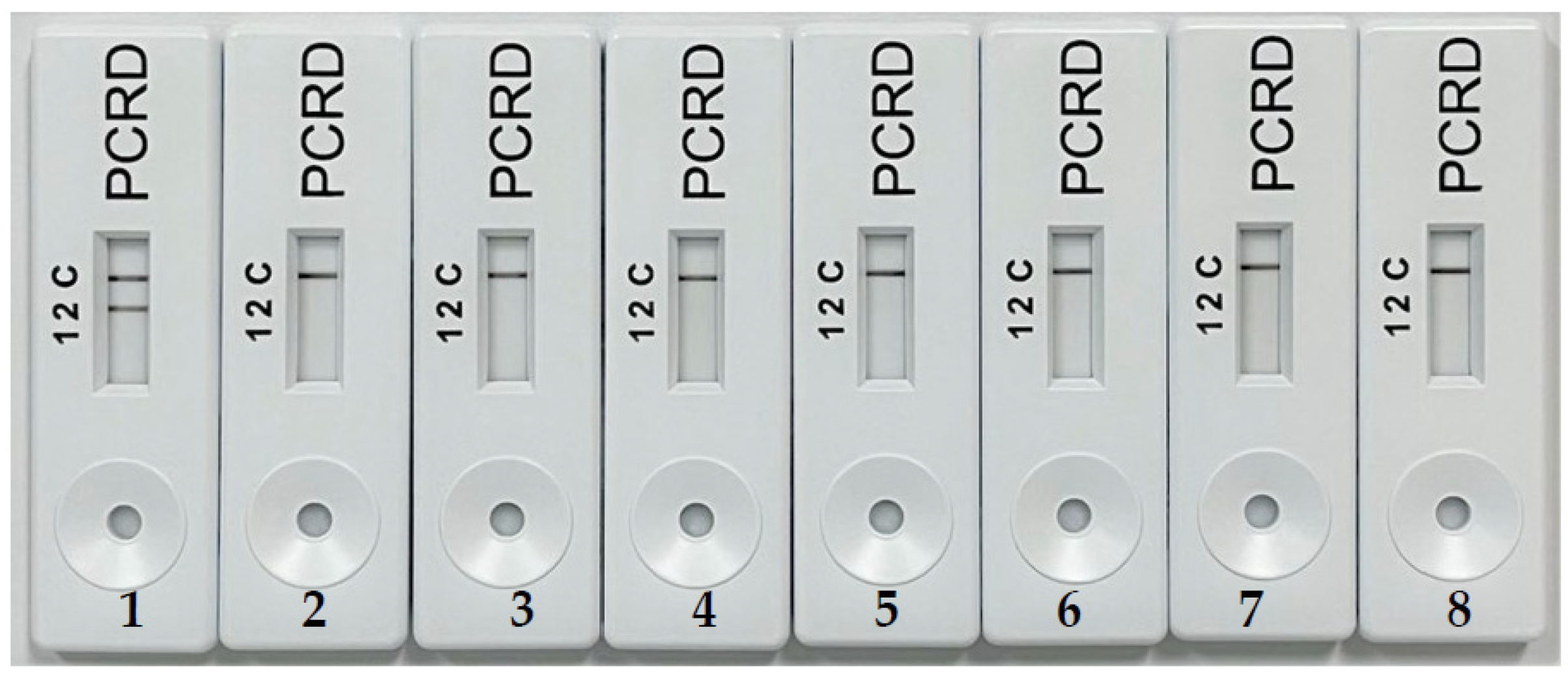
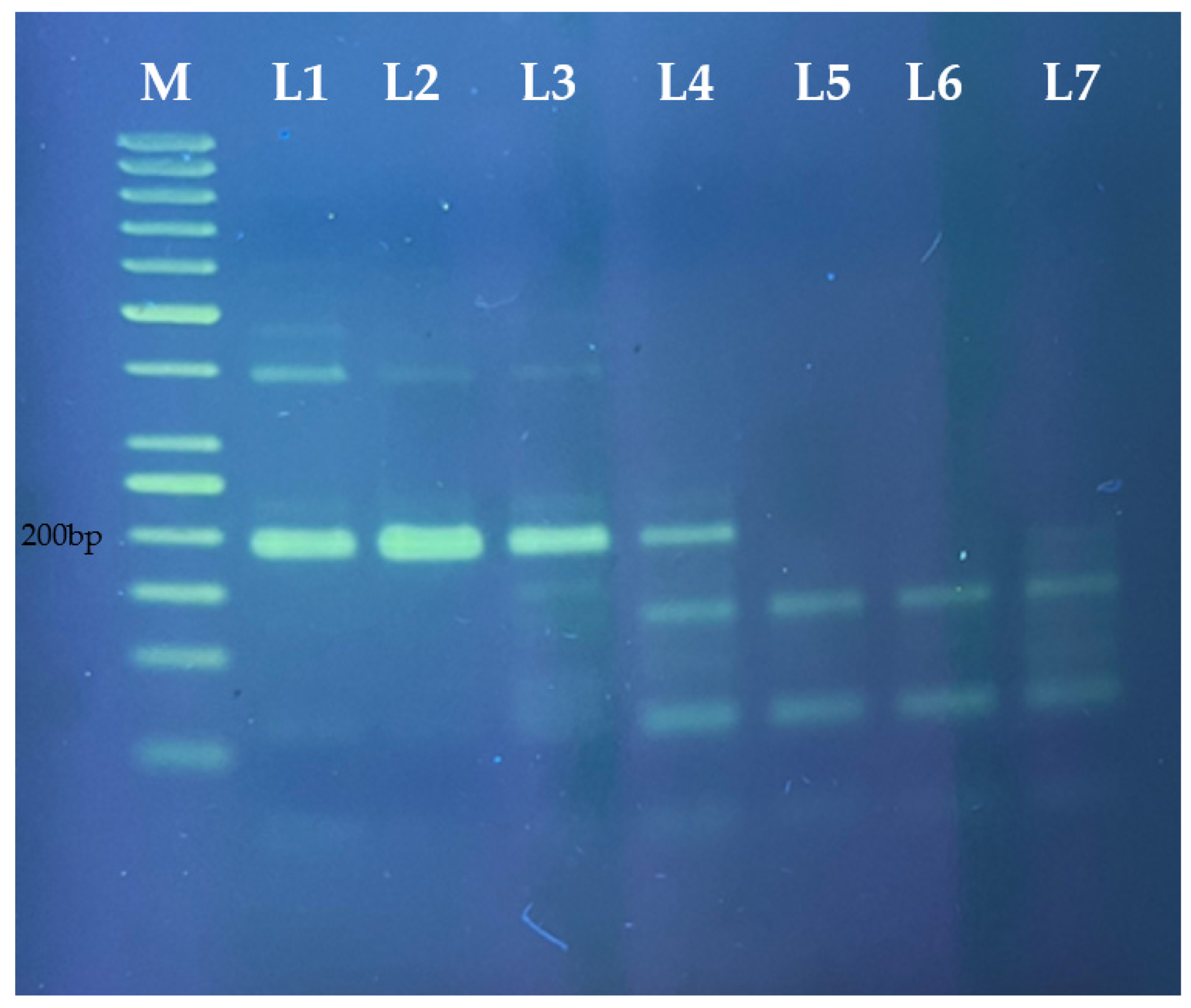
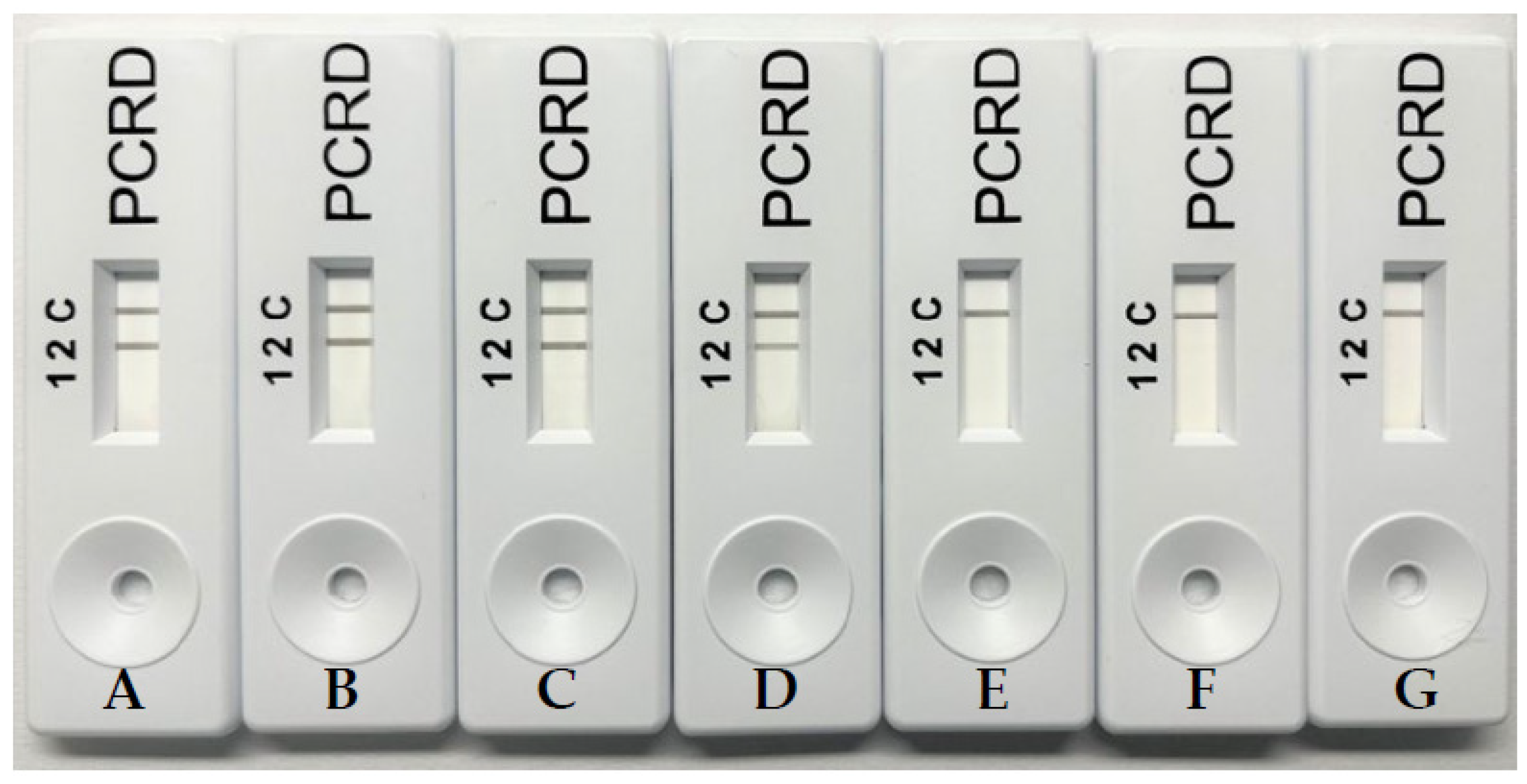
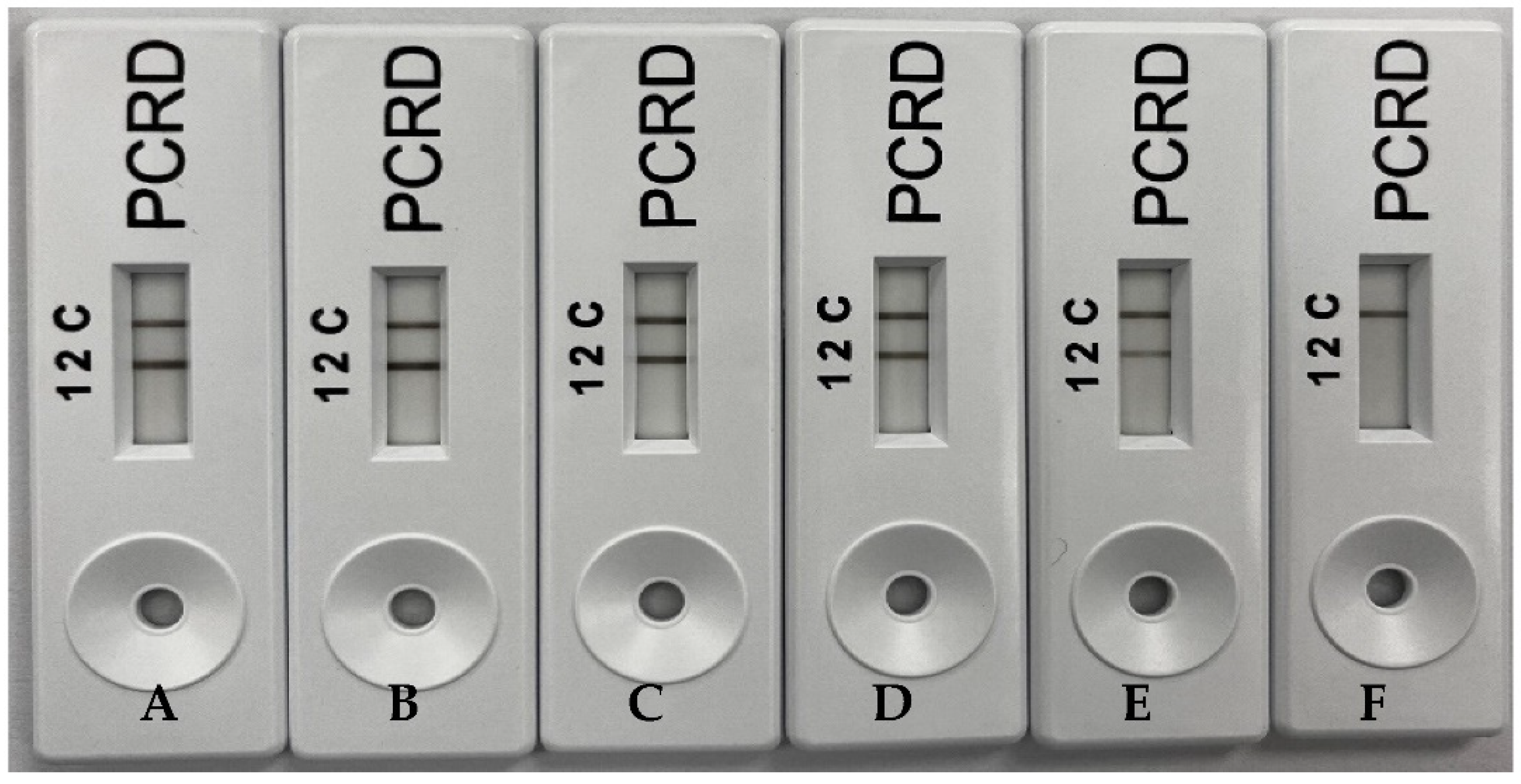
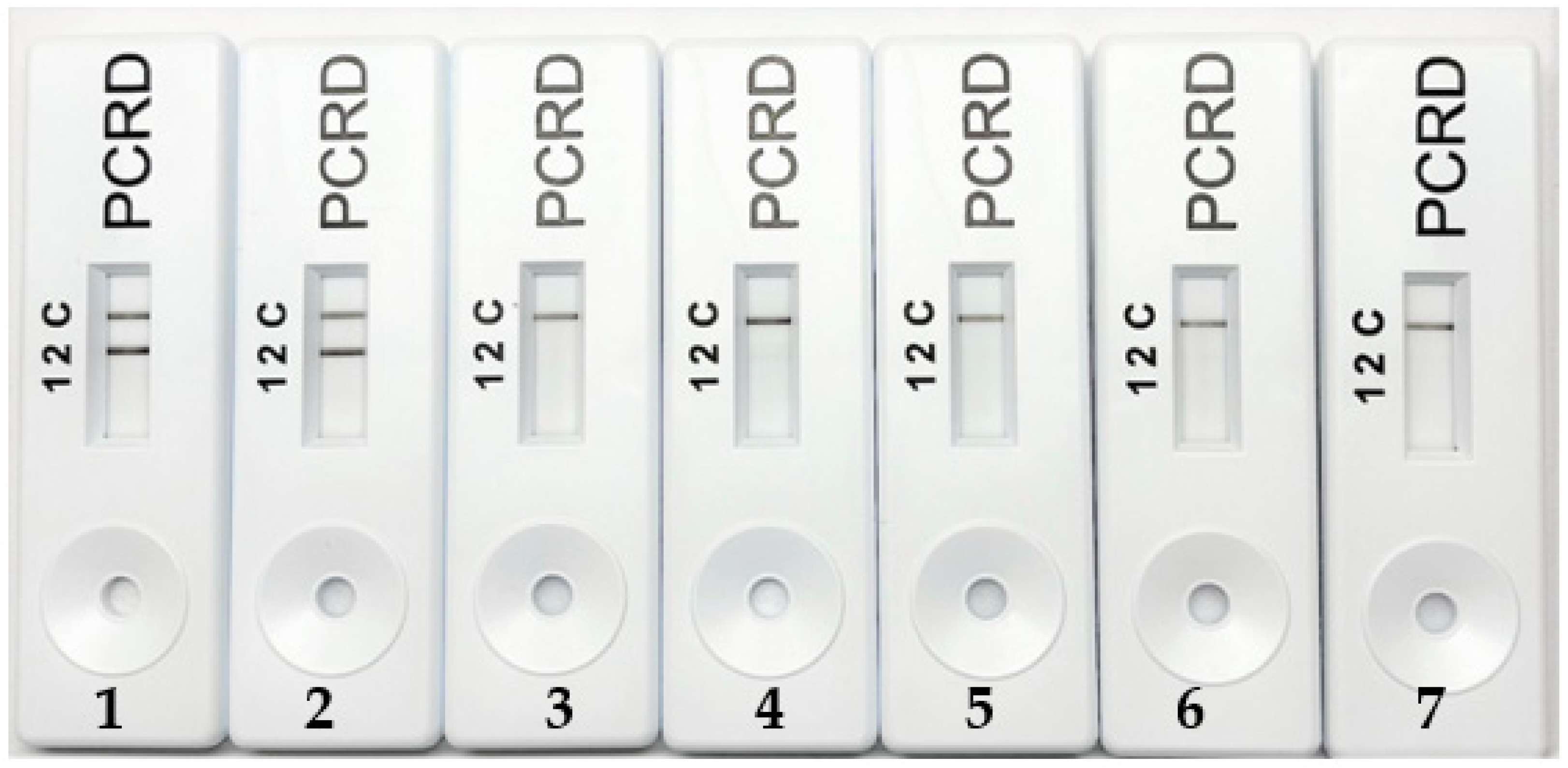
| Primers | Length | Sequences | Description |
|---|---|---|---|
| SSF3 | 33 | 5′-CACTATTAAAGACATT CTAGGAGCCTTATTTAT-3′ | Porcine Non-Labelled Forward Primer |
| SSR3 | 33 | 5′-CACCTAGTTTATTAGGAATTGAACGTAGAATAG-3′ | Porcine Non-Labelled Reverse Primer |
| SF2F | 33 | 5′FAM-CACTATTAAAGACATT CTAGGAGCCTTATTTAT-3′ | Porcine Labelled Forward Primer |
| SR2B | 33 | 5′Biotin-CACCTAGTTTATTAGGAATTGAACGTAGAATAG-3′ | Porcine Labelled Reverse Primer |
Publisher’s Note: MDPI stays neutral with regard to jurisdictional claims in published maps and institutional affiliations. |
© 2022 by the authors. Licensee MDPI, Basel, Switzerland. This article is an open access article distributed under the terms and conditions of the Creative Commons Attribution (CC BY) license (https://creativecommons.org/licenses/by/4.0/).
Share and Cite
Yusop, M.H.M.; Bakar, M.F.A.; Kamarudin, K.R.; Mokhtar, N.F.K.; Hossain, M.A.M.; Johan, M.R.; Noor, N.Q.I.M. Rapid Detection of Porcine DNA in Meatball Using Recombinase Polymerase Amplification Couple with Lateral Flow Immunoassay for Halal Authentication. Molecules 2022, 27, 8122. https://doi.org/10.3390/molecules27238122
Yusop MHM, Bakar MFA, Kamarudin KR, Mokhtar NFK, Hossain MAM, Johan MR, Noor NQIM. Rapid Detection of Porcine DNA in Meatball Using Recombinase Polymerase Amplification Couple with Lateral Flow Immunoassay for Halal Authentication. Molecules. 2022; 27(23):8122. https://doi.org/10.3390/molecules27238122
Chicago/Turabian StyleYusop, Mohd Hazim Mohd, Mohd Fadzelly Abu Bakar, Kamarul Rahim Kamarudin, Nur Fadhilah Khairil Mokhtar, Mohd Abd Motalib Hossain, Mohd Rafie Johan, and Nor Qhairul Izzreen Mohd Noor. 2022. "Rapid Detection of Porcine DNA in Meatball Using Recombinase Polymerase Amplification Couple with Lateral Flow Immunoassay for Halal Authentication" Molecules 27, no. 23: 8122. https://doi.org/10.3390/molecules27238122
APA StyleYusop, M. H. M., Bakar, M. F. A., Kamarudin, K. R., Mokhtar, N. F. K., Hossain, M. A. M., Johan, M. R., & Noor, N. Q. I. M. (2022). Rapid Detection of Porcine DNA in Meatball Using Recombinase Polymerase Amplification Couple with Lateral Flow Immunoassay for Halal Authentication. Molecules, 27(23), 8122. https://doi.org/10.3390/molecules27238122







